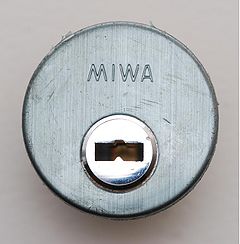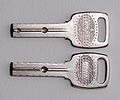MIWA EC
MIWA EC
| MIWA EC | |
 | |
| Name | MIWA EC |
|---|---|
| Manufacturer | MIWA |
| Lock Type | Cylinder |
| Lock Design | Magnetic |
| Patent | US 3,518,855 Expired 1987 |
| Related Locks | |
| MIWA 3800 | |
The EC (or Ankerslot Inline) is a magnetic lock made by MIWA. It uses up to fourteen magnetic tumblers arranged in two rows of seven on each side of the keyway. The EC is one of the few locks with no visible locking components in the keyway.
The EC has since been superceded by the MIWA 3800.
Principles of operation
The EC uses up to fourteen magnetic tumblers arranged in two rows of seven at 3 and 9 o'clock in the plug. The plug has bores on each side that do not extend into the keyway. Each tumbler is spring-biased toward a plug bore and a magnetic component in the key repels each tumbler to the shear line. Tumblers themselves are magnetic rods surrounded by a metal sleeve. Each tumbler has the opposite polarity of the corresponding key magnet and is spooled to resist manipulation.
The key itself resembles a non-symmetric dimple key with magnetic inserts on the thin side of the blade. Along the blade of the key is a dimple used to hold a ball bearing that retains the key in the lock when the plug is rotated. Unlike traditional locks, the EC offers no direct access to locking components through the keyway. The only moving part in the keyway is the ball bearing.
In practice, the EC rarely uses all fourteen chambers. Instead, master keying is provided by chambers that are left empty, with "dummy" wafers inserted into those positions on the key. In total, the EC offers 16,384 (214) theoretical key differs. The number of working keys for a given EC is 2n, where n is the number of empty chambers. Extra ball bearing dimples can be used for additional master keying capability.[1]
Disassembly instructions
The EC is moderately difficult to disassemble because there is no direct way to remove the magnetic tumblers without a working key. The plug must be rotated before it is removed from the cylinder. Failure to do so causes tumblers to block the shear line because the key magnets will line up with the wrong tumblers, pulling them back into the plug bores.
- Remove the cam or C-clip.
- Insert the correct key and turn the plug 45° clockwise.
- Remove the pin trays from the back of the lock. Be careful to not lose any pins or springs when removing the trays.
- Remove the plug from the lock.
Notes
- The cylinder can be rapped open if it can be removed from its mounting. This is particularly useful for forensic investigators.
Vulnerabilities
The EC may be vulnerable to one or more of the following:
Notes
- A magnetic decoding probe was patented in 1979 to defeat the EC, described in US 4,229,959.
Gallery
References
- ↑ PULFORD, Graham (2007). High Security Mechanical Locks: An Encyclopedic Reference. ISBN 0750684372.





